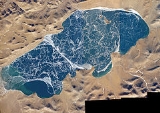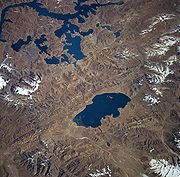
Lake Puma Yumco
Encyclopedia

Above mean sea level
The term above mean sea level refers to the elevation or altitude of any object, relative to the average sea level datum. AMSL is used extensively in radio by engineers to determine the coverage area a station will be able to reach...
on the southern Tibetan Plateau
Tibetan Plateau
The Tibetan Plateau , also known as the Qinghai–Tibetan Plateau is a vast, elevated plateau in Central Asia covering most of the Tibet Autonomous Region and Qinghai, in addition to smaller portions of western Sichuan, southwestern Gansu, and northern Yunnan in Western China and Ladakh in...
. It is 32 km (19.9 mi) long, and is 13 km (8.1 mi) wide. Streams of water from the snow-capped surrounding mountains feed the lake, but the lake has no outlet. Some sediment can be seen entering the lake at its western end.
Puma Yumco literally means The Blue Jewel which is floating in the sky. The lake freezes in winter and is crossed by shepherds with their sheep. Since the climate is warming, the ice is becoming thinner and thus creates a problem for the 120 people living off and around the lake.
The lake is considered ultraoligotrophic, meaning that nutrient concentrations in both the water column and lake sediments are extremely low. Water in such lakes tends to be blue to blue-green and to have high clarity due to low levels of photosynthesizing
Photosynthesis
Photosynthesis is a chemical process that converts carbon dioxide into organic compounds, especially sugars, using the energy from sunlight. Photosynthesis occurs in plants, algae, and many species of bacteria, but not in archaea. Photosynthetic organisms are called photoautotrophs, since they can...
organisms such as phytoplankton
Phytoplankton
Phytoplankton are the autotrophic component of the plankton community. The name comes from the Greek words φυτόν , meaning "plant", and πλαγκτός , meaning "wanderer" or "drifter". Most phytoplankton are too small to be individually seen with the unaided eye...
.
During the winter, the lake develops intricate ice block patterns on the surface, ranging from less than ten to hundreds of meters in diameter. The ice pattern is caused by repeated cycles of freezing, fracturing, and refreezing of the ice due to variations in temperature and wind-induced ice motion.

